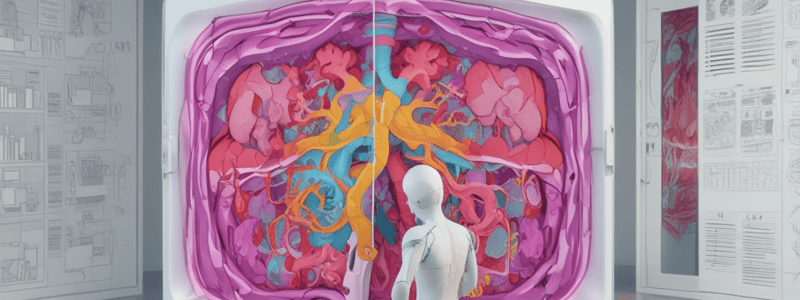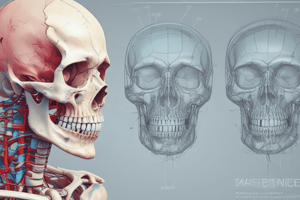Podcast
Questions and Answers
What is the purpose of the digital or convolution filter used in the CT image reconstruction process?
What is the purpose of the digital or convolution filter used in the CT image reconstruction process?
- To reduce the noise in the back-projected image
- To remove blurring from the back-projected image (correct)
- To amplify the high frequency components of the data
- To enhance the low contrast details in the image
Which of the following is a major disadvantage of the filtered back-projection (FBP) technique for CT image reconstruction?
Which of the following is a major disadvantage of the filtered back-projection (FBP) technique for CT image reconstruction?
- It is computationally intensive and time-consuming
- It requires higher radiation doses to achieve adequate image quality (correct)
- It produces images with low spatial resolution
- It is limited to small patient sizes
What is the purpose of the summation of the filtered projections in the CT image reconstruction process?
What is the purpose of the summation of the filtered projections in the CT image reconstruction process?
- To cancel out the negative and positive components, producing a blur-free image (correct)
- To improve the spatial resolution of the final image
- To enhance the contrast of the final image
- To reduce the noise in the final image
Why does the filtered back-projection (FBP) technique tend to falter in larger patients?
Why does the filtered back-projection (FBP) technique tend to falter in larger patients?
What is the primary advantage of the filtered back-projection (FBP) technique that has traditionally limited the incentive to change reconstruction methods?
What is the primary advantage of the filtered back-projection (FBP) technique that has traditionally limited the incentive to change reconstruction methods?
Which of the following is a key disadvantage of the basic back-projection technique for CT image reconstruction?
Which of the following is a key disadvantage of the basic back-projection technique for CT image reconstruction?
What is the advantage of backprojection in CT reconstruction?
What is the advantage of backprojection in CT reconstruction?
What is the purpose of the filtering step in filtered backprojection?
What is the purpose of the filtering step in filtered backprojection?
What is the first step in the filtered backprojection method?
What is the first step in the filtered backprojection method?
Why is only a 180° gantry rotation necessary to reconstruct the full CT image?
Why is only a 180° gantry rotation necessary to reconstruct the full CT image?
What is the purpose of taking the logarithm of the projection data in filtered backprojection?
What is the purpose of taking the logarithm of the projection data in filtered backprojection?
What is the purpose of the backprojection step in CT reconstruction?
What is the purpose of the backprojection step in CT reconstruction?
What is the primary purpose of image reconstruction in CT imaging?
What is the primary purpose of image reconstruction in CT imaging?
Which of the following algorithms is NOT mentioned in the text as being applicable to CT image reconstruction?
Which of the following algorithms is NOT mentioned in the text as being applicable to CT image reconstruction?
Which of the following is a key characteristic of the back-projection reconstruction technique?
Which of the following is a key characteristic of the back-projection reconstruction technique?
What is the primary difference between filtered back-projection (FBP) and iterative reconstruction (IR) techniques in CT imaging?
What is the primary difference between filtered back-projection (FBP) and iterative reconstruction (IR) techniques in CT imaging?
What is the role of the attenuation coefficient in the image reconstruction process described in the text?
What is the role of the attenuation coefficient in the image reconstruction process described in the text?
Which of the following is a key advantage of the back-projection reconstruction technique described in the text?
Which of the following is a key advantage of the back-projection reconstruction technique described in the text?
Flashcards are hidden until you start studying
Study Notes
Digital/Convolution Filters in CT Reconstruction
- Digital filters enhance CT images by improving their quality and reducing noise.
- Convolution filters help to suppress artifacts and undesirable features in reconstructed images.
Disadvantages of Filtered Back-Projection (FBP)
- FBP struggles with larger patients due to increased beam attenuation, leading to artifacts and decreased image quality.
- The technique can lead to image blurring and loss of detail, particularly in areas with less tissue density.
Purpose of Summation of Filtered Projections
- Summing filtered projections is essential to create a complete representation of the scanned area, combining multiple angles of data.
- This step integrates various projection information into a coherent image.
Comparison of FBP and Iterative Reconstruction
- FBP is fast and computationally efficient but may lack the advanced capabilities of iterative reconstruction (IR), which provides enhanced image quality.
- IR techniques can adaptively reconstruct images based on model algorithms, often leading to better handling of noise and artifacts.
Back-Projection Technique Advantages
- The primary advantage of back-projection is its simplicity and straightforward implementation, making it widely adopted in early CT systems.
- Back-projection can provide a rough initial image quickly, benefiting rapid diagnostic processes.
Filtering Step in Filtered Back-Projection
- The filtering step eliminates high-frequency noise and sharpens the edges of structures within the image.
- Proper filtering is crucial for improving the overall quality and diagnostic utility of the reconstructed image.
First Step in Filtered Back-Projection Method
- The initial phase involves acquiring projection data through the CT scanner as it rotates around the patient.
- This raw data captures various angles of attenuation, forming the base for subsequent reconstruction.
Importance of 180° Gantry Rotation
- A 180° gantry rotation is sufficient to reconstruct the full image due to the mathematical properties of Radon transform.
- This technique utilizes data from both sides of the body, enabling complete coverage of the scanned area.
Logarithm of Projection Data
- Taking the logarithm of projection data normalizes intensity variations, enhancing the accuracy of the reconstruction process.
- This step is essential for translating raw attenuation data into discernible structural information.
Back-Projection Step Purpose
- The back-projection step distributes the filtered data across the image grid, creating a comprehensive representation of the scanned area.
- This method helps reconstruct the final image by projecting the data back into spatial coordinates.
Primary Purpose of Image Reconstruction in CT Imaging
- The main goal is to create a usable, high-quality image that accurately reflects the internal structures of the patient for diagnostic purposes.
- Effective reconstruction is vital for identifying abnormalities, disease progression, and treatment planning.
Key Characteristics of Back-Projection Technique
- Basic back-projection relies on the principle of integrating multiple projections by overlapping them in space.
- While straightforward, it typically does not incorporate advanced noise reduction or artifact correction.
Role of Attenuation Coefficient
- The attenuation coefficient quantifies how much the X-ray beam is weakened as it passes through different tissues.
- This value is crucial in translating projection data into meaningful information regarding tissue density and composition.
Key Advantages of Back-Projection
- Back-projection allows for rapid initial assessments in clinical settings, facilitating quicker decision-making.
- Its ease of implementation promotes widespread usage in various CT imaging applications.
Studying That Suits You
Use AI to generate personalized quizzes and flashcards to suit your learning preferences.




